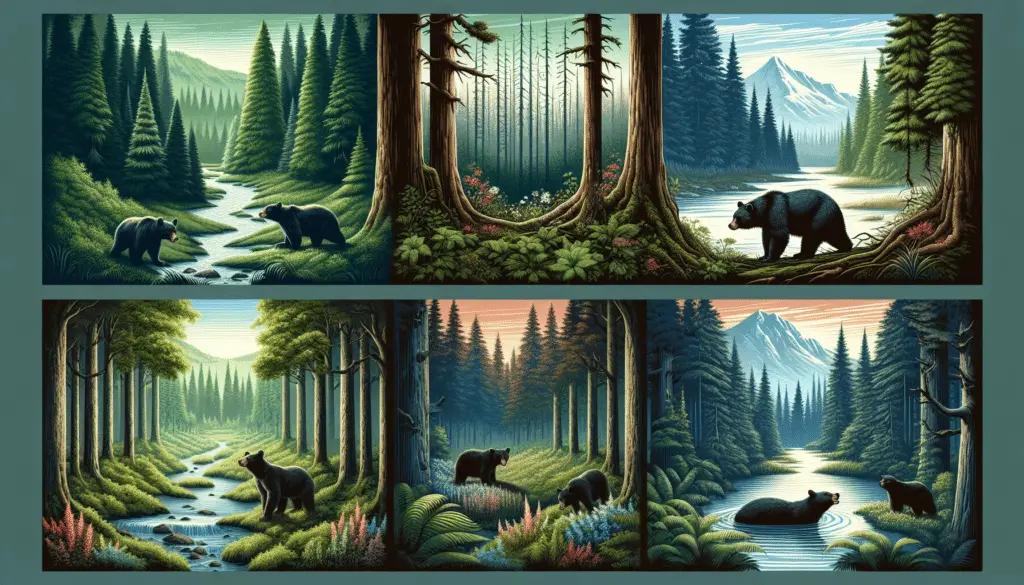Understanding Black Bear Habitats
Table of Contents
ToggleBlack bears, scientifically known as Ursus americanus, are widely distributed across North America.
As adaptable creatures, they are found in various environments from the dense forests of Canada to the swamps of Florida.
Identifying the regions where black bears thrive can provide insight into their ecology and assist in conservation efforts.
Regions Inhabited by Black Bears in North America
Dense forests offer seclusion and an abundance of food, making them a preferred habitat for black bears.
These regions include the Appalachians, the Rocky Mountains, and the northern woods stretching into Canada.
Bear populations are also abundant in the Pacific Northwest, where the forests provide plentiful berries, nuts, and salmons.
Black Bears in the United States
In the United States, black bears inhabit parts of at least 40 states, with the highest populations in the forests of Pennsylvania, the northwest Pacific coast, and the Sierra Nevada mountain range.
Contrary to their name, not all black bears boast a black coat; some display varying colors such as cinnamon or even white, as seen in the rare Kermode bear of British Columbia.
The Adaptable Diet of Black Bears
With a diet that changes seasonally, black bears are truly opportunistic eaters.
Their omnivorous behavior allows them to feed on a mix of fruits, nuts, insects, and occasional animal protein, adapting their diet to the available resources.
Black Bear Habitats in Canada and Alaska
Canada’s vast stretches of coniferous and deciduous forests present an ideal habitat for black bears, with their distribution extending from the east coast to the Yukon Territory.
In Alaska, black bears are found in most forested areas, especially in the south and southeast regions where vegetation is dense and opportunities for denning are ample.
Coexistence with Humans
As human populations expand, encounters with black bears in suburban and sometimes even urban areas are becoming more frequent.
Bears may enter neighborhoods in search of food, which highlights the importance of secure garbage storage to discourage their visitations.
Black Bears in Protected Areas and National Parks
Black bears are a common sight in protected regions like the Great Smoky Mountains National Park, where they play a vital role in the ecosystem.
These zones offer protection and management strategies to maintain bear populations while also minimizing human-bear conflicts.
Understanding Black Bear Behavior and Biology
To appreciate where black bears are found, it’s essential to understand their behavior and biology.
They are solitary animals with an acute sense of smell, which guides them to food sources and influences their movement patterns.
Safety Tips for Encountering Black Bears
For those adventuring into bear country, carrying bear spray and practicing safe food storage is pivotal.
Making noise on trails can prevent surprising a bear, and understanding their behavior can help manage encounters peacefully.
Black Bears in Different Seasons
Throughout the year, black bears traverse various habitats following food availability, with their range shrinking in winter as they hibernate in dens.
During spring and summer, they can be found foraging in lowland valleys and wetlands, while in the fall, they may venture to higher elevations seeking fruits and nuts.
Black Bear Population Management
Wildlife agencies closely monitor black bear populations to ensure their survival and to manage interactions with humans.
Through tracking, scientific research, and community education, these agencies aim to conserve bear habitats and uphold public safety.
Cross-Border Habitats of Black Bears
Black bear habitats often span across country borders, making international collaboration essential for their conservation.
In areas like the United States-Canada border, coordinated efforts help monitor and manage these transboundary populations.
FAQ: Interactions with Black Bears
What should I do if I encounter a black bear?
If you encounter a bear, remain calm, make yourself appear large, and back away slowly.
Never approach or feed a bear, and if attacked, fight back vigorously.
How can I prevent attracting black bears to my property?
To deter bears, secure your garbage, remove bird feeders, and clean grills after use.
Using bear-resistant containers and electric fencing can also help.
Are black bears dangerous to humans?
Black bears generally avoid human contact, but they can become aggressive if they feel threatened, especially females with cubs.
It’s crucial to respect their space and observe them from a safe distance.
Recommended Gear for Black Bear Territory
When exploring bear habitats, investing in quality bear-resistant containers and sprays is wise.
After thorough research, the Counter Assault Bear Spray has emerged as a top choice for many outdoor enthusiasts.
Based on reviews, this spray is highly effective with a broad cloud pattern and significant range, giving users confidence during potential encounters.
Find This and More on Amazon
What is the best time of day to view black bears?
Bears are most active during dawn and dusk, which are the ideal times to observe them in the wild.
However, always ensure your safety by maintaining a respectable distance and staying alert to your surroundings.
Final Thoughts on Black Bear Habitats
Black bears are a symbolic species of North America’s wilderness areas, occupying a range of habitats that reflect their adaptability and resilience.
Through collaboration in conservation efforts and the adoption of best practices for coexistence, we can ensure the continued presence of these iconic animals in their natural landscapes.
Seasonal Shifts in Black Bear Habitats
The habitat preferences of black bears fluctuate with the changing seasons.
In the spring, they emerge from hibernation and often travel to lower elevations in search of buds, shoots, and carrion from winter-killed animals.
During the summer, berry-producing shrubs and trees become the centerpieces of their diet, often resulting in bears frequenting the edges of woodlands and forest clearings where such plants are abundant.
As fall approaches, acorns, nuts, and other mast form a significant part of their foraging as they prepare for the winter denning period.
Hibernation Habits of Black Bears
Understanding the hibernation habits of black bears provides a glimpse into their survival strategies.
The dens they select for hibernation can range from hollowed-out tree cavities to burrows dug into hillsides.
Hibernation dens are often located in secluded and secure areas to minimize disturbances during their vulnerable rest period.
Tracking and Researching Black Bears
Scientists use a variety of methods to track and understand black bears, from radio collars to DNA analysis.
By analyzing bear movements and behavior, they gain insights into habitat preferences and population health.
Such research informs management practices and helps predict how bears may respond to changes in their environment, such as urban expansion or climate change.
Black Bears and Conservation Efforts
Efforts to protect black bear habitats have been stepped up in recent years, acknowledging their role as keystone species in North America’s ecosystems.
Conservation groups and government agencies work to preserve critical areas like wildlife corridors that facilitate bear movement and reduce habitat fragmentation.
Innovations in Bear-Proofing Techniques
As humans and black bears continue to share spaces, innovative bear-proofing techniques are vital for coexistence.
From bear-proof trash cans to modifications in agricultural practices, these techniques aim to minimize attractants that can lead to bear-human conflicts.
Black Bears and Climate Change
As with many species, black bears face challenges posed by climate change.
Shifting weather patterns can affect food availability and denning behaviors, potentially altering their distributions and habits.
Understanding these impacts is crucial for ongoing conservation and management efforts.
Importance of Public Education about Black Bears
Public education plays a crucial role in black bear conservation.
Informing communities about bear behavior and how to interact safely with these animals is key to reducing conflicts and fostering a harmonious coexistence.
Black Bears as an Indicator Species
Black bears are often seen as indicator species for ecosystem health, because their well-being reflects the state of their environment.
Their presence and abundance can be a sign of a thriving, balanced ecosystem.
Black Bear Predators and Threats
While adult black bears have few natural predators, cubs are vulnerable to predation by animals like coyotes or mountain lions.
Human activity, including habitat loss, poaching, and vehicle collisions, poses significant threats to black bear populations.
FAQ: Understanding Black Bears
How do black bears communicate with each other?
Black bears communicate through vocalizations, body language, and scent markings.
They may grunt, moan, or clack their teeth to convey various messages, from courting to feeling threatened.
What is the average lifespan of a black bear?
In the wild, black bears can live up to 20 years, though their lifespan may decrease due to factors like accidents or disease.
In protected areas or captivity, they have been known to live even longer.
Do black bears play any role in indigenous cultures?
Yes, black bears hold significant cultural and spiritual importance for many indigenous peoples across North America.
They are respected and often featured in myths, legends, and totemic practices.
Observing Black Bears in Their Natural Habitat
For wildlife enthusiasts hoping to observe black bears in their natural habitat, it’s important to do so responsibly.
Guided tours and bear-watching expeditions can provide safe and educational experiences.
If you’re heading out on your own, remember to check local guidelines, stay on marked trails, and always keep a safe distance from the animals.
Tools for Tracking and Watching Black Bears
Today, various technologies and tools can aid in tracking and observing black bears.
For example, trail cameras have become an invaluable resource for researchers and enthusiasts alike, providing intimate glimpses into the lives of bears without disturbing them.
Field guide books and apps can also enhance the bear-watching experience by helping to identify signs of bear presence, such as tracks or scat.
Conserving the Ecology of Black Bear Habitats
Protecting the habitats of black bears is protecting the richness of our natural heritage.
Enabling these creatures to thrive ensures the health and diversity of the forests, plants, and other wildlife they interact with.
By understanding and supporting black bear habitats, we contribute to the larger efforts of preserving our planet’s biodiversity.



